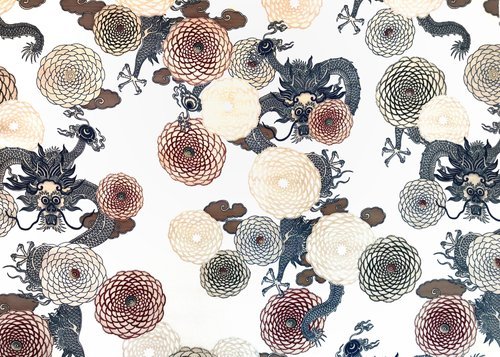THE JAPANESE DRAGON - MYTHS, LEGENDS, AND SYMBOLISM
Dragons from Japanese folk-lore are most definitely a favorite re-occurring design theme at PagongKyoto; designs such as Ikyu’s Dragon (shown above), also Water Dragon, Dragon and Chrysanthemums and Rising Dragon (shown below) all brimming with protective energy, power, and of course charm!
SUI RYU “WATER DRAGON”
But where did the belief in these incredible creatures originate? This started us wondering, so we thought we’d try to find out. Many scholars of mythology seem to agree that believing in dragons probably evolved independently in both Europe and Asia, and perhaps in the Americas and Australia as well. Many have even speculated about which “real-life” animals might have inspired the very first dragon tales…It seems ancient people may have discovered dinosaur fossils, whale bones, or combinations of large predator’s bones, and understandably misinterpreted them as the remains of dragons.
A Japanese dragon, also known as RYU or TATSU, first appears in Japanese mythology as far back as 680 A.D. In fact, Japanese dragons are believed to be the ancestors of the first Emperor of Japan holding importance and significance as a symbol for the emperor. In particular the “five-clawed dragon”, considered to be god-like is said to have been worn on robes only by nobles and therefore is highly respected and honored in Japanese society.
KIKKA TO RYU “DRAGON AND CHRYSANTHEMUMS” depicting a ”five-clawed dragon”
There is a well-known legend about a “dragon king”, who is said to live in a pond at Shinzen’en, the emperor’s imperial garden of Kyoto. During times of drought in ancient times, Buddhist monks held rituals there, to persuade the dragon king to rise up and bring rain. Perhaps this is why this area’s dragon is associated with having full control over having a good harvest, representing the wealth, and abundance of the region.
RISING DRAGON
Another accepted belief is that dragons are a “deity of the sea” and have the power to transform into any shape and size, making them creatures capable of magical powers, and transformation, therefore appearing in many dramatically fantastic forms. With the dragon’s magic jewels, he is responsible for the tides, and represents both the “perils” as well as the “bounty of the sea”. Along with this belief, his residence is in a palace beneath the sea or in a lake of an extinct volcano. The depths of Lake Biwa, just north-east of Kyoto, are often cited as the “home” of Ryu.
RYU JIN “DRAGON GOD”
All in all, Japanese dragons are revered as the benefactors and protectors of mankind; powerful and wise guardians that shield us from universal dangers, and impart their wisdom. A symbol of good fortune and wealth, they bring us happiness, offering us strength and courage at each important turning point in our lives.
Dragon Items>>>






